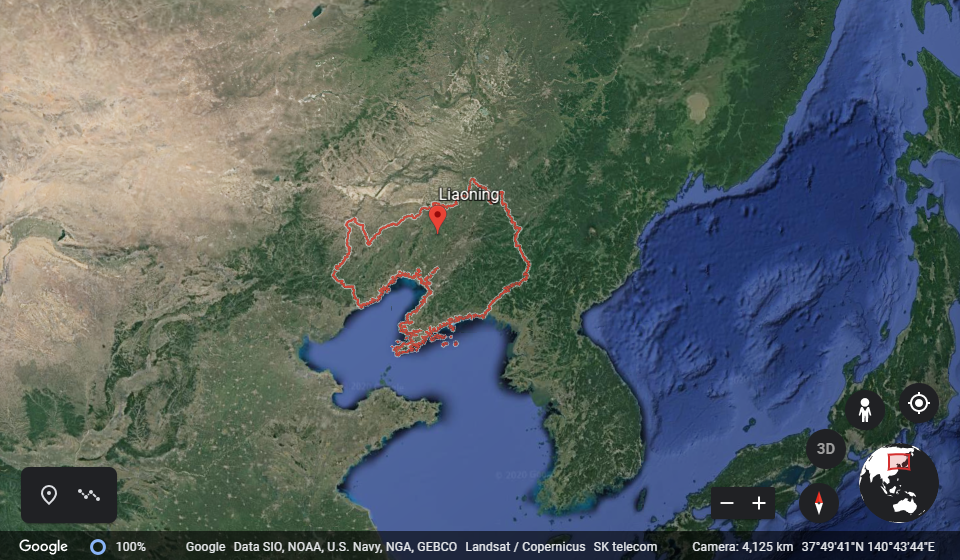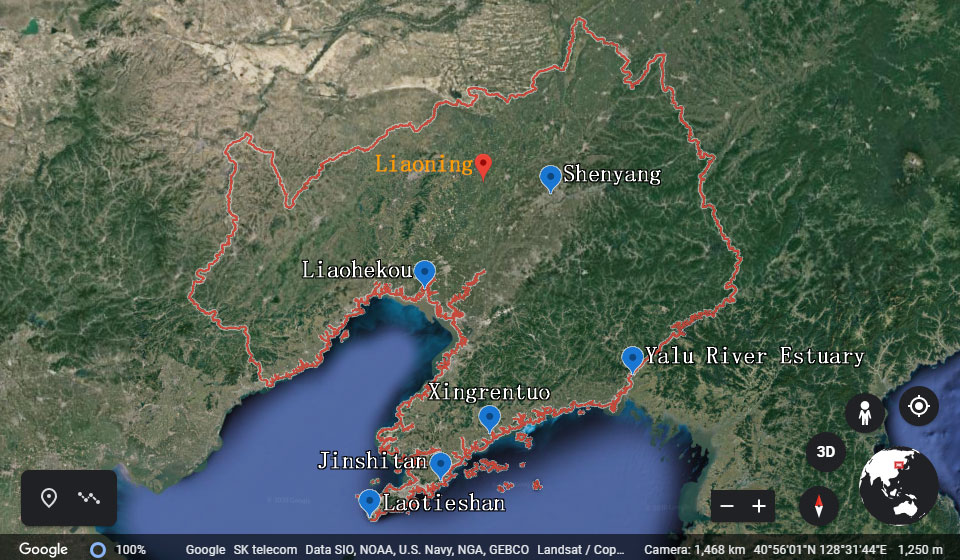Birding info of Liaoning, China

Located in the south of Northeast China and facing Korea across the Yalu River, Liaoning Province covers 148,000 square kilometers of land territory and 68,000 square kilometers ocean territory with 2,100km coastline. In terms of topography, Liaoning consists of roughly three approximate geographical regions: the highlands in the west, plains in the middle, and hills in the east.
Liaoning has abundant water resources with more than 300 rivers and 1,000 reservoirs. The province is also rich in wetland resources including offshore and coastal wetlands, river wetlands, lakeside wetlands, reservoirs wetlands, and swamps and marsh wetlands, totally occupying more than 1.22 million hectares. Liaoning province also has more than 530 million hectares of forests with 2,200 kinds of higher plants. As an important migration stopover place for waterfowls and raptors, and migrating birds in northeast China, Liaoning Province has recorded a large number of water birds. Of the 418 bird species totally recorded in the province, there are 163 species of water birds, accounting 38.75% of the total in the province. In Liaoning province there are 207 species of passing migrant birds, accounting for 49.52%. And of the total 61 species shorebirds, 46 species are in Liaoning, the number reaching more than 20,000.
Liaoning has a continental monsoon climate, and rainfall averages to about 440 to 1,130 mm annually. Summer is rainy while the other seasons are dry. The capital of Liaoning Province is Shenyang, which has a history of 2,300 years.
Some Important Birding Sites in Liaoning

Liaohekou Nature Reserve
Located in Panjin City and coastal area of Liaodong Bay in Jinzhou city, the reserve consists of alluvial wetlands in lower reaches of rivers and features abundant water resources, wide mudflat, and vast reed swamp. It is the largest reed marsh in high latitudes areas of China. Set up in 1985, the reserve was upgraded to national nature reserve in 1988 with size expanded from 128,000 hectares to 800,000 hectares. The goal of the reserve is to protect the endangered and rare waterfowls and the marsh ecosystem. The reserve has the world's largest reed field which is home to 263 bird species including Red-crowned Crane, Mandarin Duck, Ferruginous Duck, Black-winged Stilt, Eurasian Oystercatcher, Grey-headed Lapwing, Lesser Sand Plover, Kentish Plover, Far Eastern Curlew, Eurasian Curlew, Black-tailed Godwit, Ruddy Turnstone, Red Knot, Great Knot, Terek Sandpiper, Oriental Pratincole, Saunders's Gull, Caspian Tern, Eurasian Spoonbill, Eurasian Hobby, Chinese Penduline Tit, Oriental Reed Warbler, Reed Parrotbill, Siberian Rubythroat, Pallas's Reed Bunting, etc.
Yalu River Estuary
Located in Donggang City in Liaoning province, the reserve covers 108,000 hectares and consists of reed marsh, tidal flat, and some farmlands. The reserve was set up in 1997 and is an important stopover for migrant birds in Northeast Asia. The long distance migrant birds which go to New Zealand and Australia for wintering and to Siberia for breeding have their weight reduced by half after 6,500km non-stop flying. With sound ecological environment, Yalu River Estuary becomes their best feeding place. The reserve has recorded 240 bird species under 41 families. Such as Eastern Spot-billed Duck, Goosander, Eurasian Oystercatcher, Grey Plover, Pacific Golden Plover, Lesser Sand Plover, Kentish Plover, Far Eastern Curlew, Eurasian Curlew, Bar-tailed Godwit, Ruddy Turnstone, Great Knot, Red Knot, Red-necked Stint, Dunlin, Terek Sandpiper, Saunders's Gull, Peregrine Falcon, Pallas's Reed Bunting, Black-faced Bunting, etc.
Laotieshan Nature Reserve
It is located in the southernmost of the Liaodong Peninsula. The reserve was established in 1980. The main vegetation of the reserve is man-made and secondary forests. There are rivers and reservoirs in this reserve. The unique geographic situation makes this reserve main passage and stopover for migrant birds in East Asia. There are millions of migrant birds pass here every year. Such as Osprey, Crested Honey-buzzard, Greater Spotted Eagle, Booted Eagle, Grey-faced Buzzard, Eastern Marsh Harrier, Pied Harrier, Japanese Sparrowhawk, Eurasian Sparrowhawk, Northern Goshawk, Black Kite, Eastern Buzzard, Amur Falcon, Eurasian Hobby, Peregrine Falcon, Chinese Egret, Yellow Bittern, Black-tailed Gull, Bull-headed Shrike, Yellow-bellied Tit, Thick-billed Warbler, Black-browed Reed Warbler, Lanceolated Warbler, Pallas's Grasshopper Warbler, Radde's Warbler, Brown-eared Bulbul, Beijing Babbler, Siberian Rubythroat, Siberian Blue Robin, Pechora Pipit, Yellow-billed Grosbeak, Chestnut-eared Bunting, Yellow-throated Bunting, Yellow-browed Bunting, etc.
Xingrentuo Reserve
Located in 5 km to the southeast of Shicheng Island, the reserve consists of two islands named Xingrentuo and Yuanbaotuo. From 1999 on, it has been protected as a no-hunting area. In 2006, the reserve was set up. So far Xingrentuo Island is the only breeding spot of Black-faced Spoonbill (Platalea minor) in China, with total population of 2,250 in the world, the black-faced spoonbill is one of the most endangered waterfowl. There are also more than 3,000 Black-tailed Gull (Larus crassirostris) and Herring Gull (Larus argentatus) fly to Xingrentuo for building their nests and breed.
Jinshitan
Jinshitan Scenic Area, also known as the Golden Pebble Beach National Resort, is situated in the Liaodong Peninsula and facing the Huanghai River. It is about 50 kilometers away from the northeast of Dalian City. It comprises two peninsulas with a spacious beach in-between, with a land area of 62 square kilometers and a water surface of 58 square kilometers. Encircled by sea all around, the beach enjoys a coastline of 30 kilometers. The region has an oceanic monsoon climate, with mild temperature and a distinct four seasons. Environment here is among the best throughout the country. Fresh air, clean sea water and spacious beach that extended 4 kilometers along the coast line. The unique geographic situation makes this reserve main passage and stopover for migrant birds in East Asia. There are millions of migrant birds pass here every year. Such as Whooper Swan, Ruddy Shelduck, Common Shelduck, Garganey, Northern Shoveler, Common Pochard, Ferruginous Duck, Baer's Pochard, Tufted Duck, Greater Scaup, Common Goldeneye, Smew, Goosander, Red-breasted Merganser, Japanese Quail, Hill Pigeon, Black-winged Stilt, Eurasian Oystercatcher, Grey Plover, Pacific Golden Plover, Kentish Plover, Little Ringed Plover, Whimbrel, Far Eastern Curlew, Eurasian Curlew, Bar-tailed Godwit, Great Knot, Sharp-tailed Sandpiper, Long-toed Stint, Terek Sandpiper, Marsh Sandpiper, Wood Sandpiper, Black-tailed Gull, Chinese Egret, Japanese Sparrowhawk, Eurasian Sparrowhawk, Northern Goshawk, Rough-legged Buzzard, Eastern Buzzard, Upland Buzzard, Eurasian Hobby, Peregrine Falcon, Chinese Grey Shrike, Chinese Penduline Tit, Zitting Cisticola, Black-browed Reed Warbler, Brown-eared Bulbul, Yellow-browed Warbler, Dusky Warbler, Beijing Babbler, Naumann's Thrush, Siberian Accentor, Red-throated Pipit, Meadow Bunting, Yellow-throated Bunting, Pallas's Reed Bunting, etc.
Last one: Birding info of Jilin, China
Next one: Birding info of Ningxia, China







